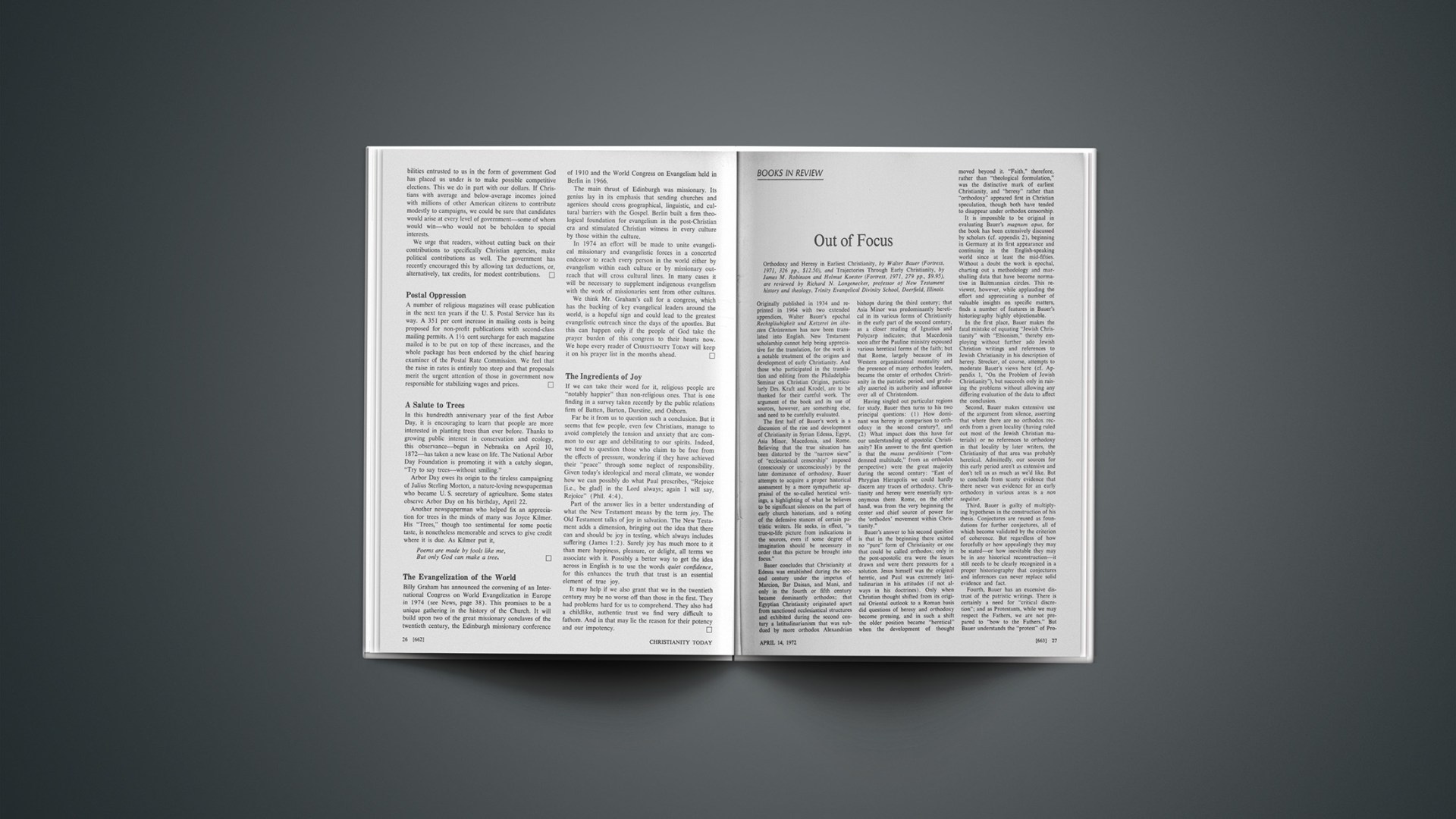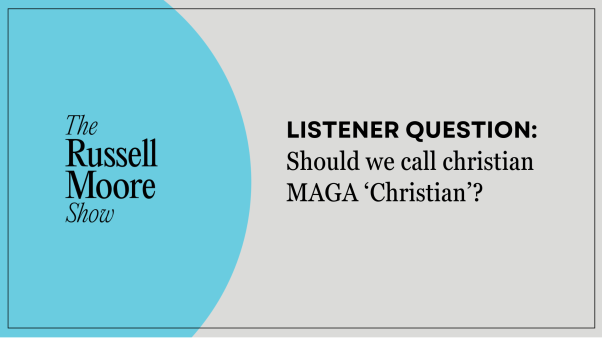Out Of Focus
Orthodoxy and Heresy in Earliest Christianity, by Walter Bauer (Fortress, 1971, 326 pp., $12.50), and Trajectories Through Early Christianity, by James M. Robinson and Helmut Koester (Fortress, 1971, 279 pp., $9.95), are reviewed by Richard N. Longenecker, professor of New Testament history and theology, Trinity Evangelical Divinity School, Deerfield, Illinois.
Originally published in 1934 and reprinted in 1964 with two extended appendices, Walter Bauer’s epochal Rechtgläubigkeit und Ketzerei im ältesten Christentum has now been translated into English. New Testament scholarship cannot help being appreciative for the translation, for the work is a notable treatment of the origins and development of early Christianity. And those who participated in the translation and editing from the Philadelphia Seminar on Christian Origins, particularly Drs. Kraft and Krodel, are to be thanked for their careful work. The argument of the book and its use of sources, however, are something else, and need to be carefully evaluated.
The first half of Bauer’s work is a discussion of the rise and development of Christianity in Syrian Edessa, Egypt, Asia Minor, Macedonia, and Rome. Believing that the true situation has been distorted by the “narrow sieve” of “ecclesiastical censorship” imposed (consciously or unconsciously) by the later dominance of orthodoxy, Bauer attempts to acquire a proper historical assessment by a more sympathetic appraisal of the so-called heretical writings, a highlighting of what he believes to be significant silences on the part of early church historians, and a noting of the defensive stances of certain patristic writers. He seeks, in effect, “a true-to-life picture from indications in the sources, even if some degree of imagination should be necessary in order that this picture be brought into focus.”
Bauer concludes that Christianity at Edessa was established during the second century under the impetus of Marcion, Bar Daisan, and Mani, and only in the fourth or fifth century became dominantly orthodox; that Egyptian Christianity originated apart from sanctioned ecclesiastical structures and exhibited during the second century a latitudinarianism that was subdued by more orthodox Alexandrian bishops during the third century; that Asia Minor was predominantly heretical in its various forms of Christianity in the early part of the second century, as a closer reading of Ignatius and Polycarp indicates; that Macedonia soon after the Pauline ministry espoused various heretical forms of the faith; but that Rome, largely because of its Western organizational mentality and the presence of many orthodox leaders, became the center of orthodox Christianity in the patristic period, and gradually asserted its authority and influence over all of Christendom.
Having singled out particular regions for study, Bauer then turns to his two principal questions: (1) How dominant was heresy in comparison to orthodoxy in the second century?, and (2) What impact does this have for our understanding of apostolic Christianity? His answer to the first question is that the massa perditionis (“condemned multitude,” from an orthodox perspective) were the great majority during the second century: “East of Phrygian Hierapolis we could hardly discern any traces of orthodoxy. Christianity and heresy were essentially synonymous there. Rome, on the other hand, was from the very beginning the center and chief source of power for the ‘orthodox’ movement within Christianity.”
Bauer’s answer to his second question is that in the beginning there existed no “pure” form of Christianity or one that could be called orthodox; only in the post-apostolic era were the issues drawn and were there pressures for a solution. Jesus himself was the original heretic, and Paul was extremely latitudinarian in his attitudes (if not always in his doctrines). Only when Christian thought shifted from its original Oriental outlook to a Roman basis did questions of heresy and orthodoxy become pressing, and in such a shift the older position became “heretical” when the development of thought moved beyond it. “Faith,” therefore, rather than “theological formulation,” was the distinctive mark of earliest Christianity, and “heresy” rather than “orthodoxy” appeared first in Christian speculation, though both have tended to disappear under orthodox censorship.
It is impossible to be original in evaluating Bauer’s magnum opus, for the book has been extensively discussed by scholars (cf. appendix 2), beginning in Germany at its first appearance and continuing in the English-speaking world since at least the mid-fifties. Without a doubt the work is epochal, charting out a methodology and marshalling data that have become normative in Bultmannian circles. This reviewer, however, while applauding the effort and appreciating a number of valuable insights on specific matters, finds a number of features in Bauer’s historiography highly objectionable.
In the first place, Bauer makes the fatal mistake of equating “Jewish Christianity” with “Ebionism,” thereby employing without further ado Jewish Christian writings and references to Jewish Christianity in his description of heresy. Strecker, of course, attempts to moderate Bauer’s views here (cf. Appendix 1, “On the Problem of Jewish Christianity”), but succeeds only in raising the problems without allowing any differing evaluation of the data to affect the conclusion.
Second, Bauer makes extensive use of the argument from silence, asserting that where there are no orthodox records from a given locality (having ruled out most of the Jewish Christian materials) or no references to orthodoxy in that locality by later writers, the Christianity of that area was probably heretical. Admittedly, our sources for this early period aren’t as extensive and don’t tell us as much as we’d like. But to conclude from scanty evidence that there never was evidence for an early orthodoxy in various areas is a non sequitur.
Third, Bauer is guilty of multiplying hypotheses in the construction of his thesis. Conjectures are reused as foundations for further conjectures, all of which become validated by the criterion of coherence. But regardless of how forcefully or how appealingly they may be stated—or how inevitable they may be in any historical reconstruction—it still needs to be clearly recognized in a proper historiography that conjectures and inferences can never replace solid evidence and fact.
Fourth, Bauer has an excessive distrust of the patristic writings. There is certainly a need for “critical discretion”; and as Protestants, while we may respect the Fathers, we are not prepared to “bow to the Fathers.” But Bauer understands the “protest” of Protestant to mean antagonism, and thereby vitiates the evidence from this source.
On the other hand, fifth, he has an overly high view of the veracity of the heretical writings and cause. In opposition to the Fathers, who demonstrate “a pronounced inability to admit anything good about the heretics,” Bauer finds it difficult to say anything bad.
Sixth, Bauer has a decided tendency to oversimplify issues and run roughshod over evidence that fails to support his view. If Bauer, for instance, had interpreted the data regarding Rome as he does the writings of Ignatius, he could argue that heresy controlled the capital of the empire as well. Likewise, his treatment of orthodoxy in the New Testament is a classic example of a conclusion in search of support.
Finally, Bauer has been insensitive to what may be called, in James Moffatt’s expression, “the sense of Center in early Christianity.” He has focused on the “diverse patterns” within the New Testament and post-apostolic Christianity, but has ignored the possibility of various circumstantial expressions of a basically common core. He has rightly noted the fact of diversity but failed to note the sense of unity and commonality, and this is a serious gap in his treatment.
The book by Robinson and Koester, Trajectories Through Early Christianity, blends Walter Bauer’s historical understanding of early Christianity with Rudolf Bultmann’s philosophical understanding of the nature of Christian faith, thereby seeking to foster “the current indigenization of the Bultmann tradition on American soil.” In the opening chapter, Robinson pleads that we replace “the traditional static, substantival, essence/accidence-oriented metaphysics” with “a dynamic, historic, existence/process-oriented new metaphysics,” for “that traditional metaphysics has loaded our concept of reality in a way prejudicial to our own being as historic persons.” In the closing chapter, Koester asserts that to make proper headway in the study of early Christianity and our understanding of the Christian faith, we must recognize that (1) such distinctions as canonical and noncanonical, orthodox and heretical, are obsolete, (2) the gospel form and content have parallels in the non-Christian world, (3) “divine man literature” (the deity of Christ) is not confined to the New Testament, and (4) every philosophy of history and explanation of faith is totally culturally conditioned. The six chapters between these two chapters are traditio-historical studies tracing out particular movements of thought during the early Christian centuries in demonstration of this view.
The presentations of Bauer, Strecker, Robinson, and Koester in these two books are attempting to deal with the phenomena of diversity and development in early Christianity. The subject is both historically significant and personally relevant to the nature of Christian faith today. And it is increasingly so, what with the discovery of the Dead Sea Scrolls and the Nag Hammadi texts.
But while applauding the effort and appreciating a number of valuable insights on specific points, this reviewer cannot help being convinced that the issues and data in question have been put in more accurate focus historically and more proper fashion theologically by such writings as H. E. W. Turner’s The Pattern of Christian Truth (1954), Jean Daniélou’s The Theology of Jewish Christianity (1964), and his own The Christology of Early Jewish Christianity (1970).
All Creation Waits
Nature: Garden or Desert, by Eric C. Rust (Word, 1971, 150 pp., $4.95), and In Defense of People, by Richard Neuhaus (Macmillan, 1971, 315 pp., $6.95), are reviewed by James M. Houston, principal of Regent College, Vancouver.
Although books on the environmental issue are already legion, relatively few give a Christian perspective. In a useful contribution to the discussion Eric Rust attempts to deal with the subject from a theological perspective. His contention is that we must take much more seriously than we have done the tie that binds the redemption of nature with the redemption of man and of his social order.
In five chapters Rust considers the biblical approach to nature, the scientific background of the environmental issue, man viewed as a predator, contemporary philosophical and theological insights, and the relations of theology and ecology. Much that he says is suggestive, but perhaps the weakness of the book lies in its broad sweeps. The work is an uncritical summary of ideas culled from scholars of very different positions: Tillich, Bloch, Pannenberg, Moltmann, Whitehead, and Heim. Nor is the author critical enough about the eco-enthusiasts—their motivations and presuppositions. Rust ends without creating an effective synthesis or an original perspective.
The author of In Defense of People is much more illuminating and incisive about the environmental movement. His subtitle is Ecology and the Seduction of Radicalism. Neuhaus does not suggest that “pollution and unlimited population growth are not very real or serious problems”; rather, he warns us against dangers in the current response to these problems.
Rust argues that the Church has failed to be the social conscience of the community. “Perhaps we can exercise our Christian responsibility better when it applies to our natural environment!” he suggests. Here Neuhaus is more realistic, for he warns us of the unrighteousness of putting the “right of nature” first before the “right of man.”
Neuhaus thinks that eco-enthusiasts have diverted attention from the racial issue, the poverty of the inner city, and the underdeveloped third world. Intellectuals are using ecological concern as a substitute for moral purpose, he says, while parts of the counterculture are using it as a new religion. He describes the manufacture of crisis by the revolutionary mood of our times, and discusses the totalitarianism inherent in the control of the “population bomb.” He also spotlights big industry’s profit-motivated attempts to make business out of the environmental campaign. Altogether the book is a sharply worded, critical, and original study of a humanistic radical. Neuhaus, pastor of the Lutheran Church of St. John the Evangelist in Brooklyn, has himself participated in political radicalism, over both Viet Nam and racial injustice.
Unfortunately neither book has an index, surely necessary in dealing with such wide issues and disciplines. Rust’s book is more scholarly and theological, but Neuhaus points up more effectively how the ecology movement has capitalized on the disillusionment and moral nihilism of American society.
Believing The Witness
The Formation of the Resurrection Narratives, by Reginald H. Fuller (Macmillan, 1971, 225 pp., $6.95), is reviewed by George Eldon Ladd, professor of New Testament exegesis and theology, Fuller Theological Seminary, Pasadena, California.
Theological literature sometimes appears in cycles. Fuller notes in his opening pages that no critical study of the resurrection narratives to probe the historical basis of the proclamation has been undertaken in the English-speaking world for over a generation. Since he wrote these words two such books have appeared, those by Willi Marxsen and C. F. Evans. Fuller’s primary purpose is not to discuss the facticity and the theology of the resurrection of Christ, but “to reconstruct the history of the tradition from its earliest recoverable form in allegedly factual reports.”
Much of the book is devoted to a “redaction” study of the Gospels. Because Fuller thinks the gospel records are full of inconsistencies and contradictions, he finds them to be of little historical value for determining what really happened. They have value, however, in revealing the way the early Church expressed its faith in the resurrection: “Resurrection faith then becomes not a matter of believing in the historical accuracy of these narratives but of believing the proclamation which these narratives, for all their differences, enshrine.” This is a technical study that will confuse the ordinary layman and be of interest only to professional critics and to those who want to see how an advanced criticism works.
One cannot avoid asking: After engaging in his extensive critical dissection, does Fuller think the New Testament requires us to believe that the resurrection actually occurred? The answer is yes. Fuller believes that the earliest Easter tradition is found in First Corinthians 15 and is basically trustworthy. He believes that some real event, which cannot be described in terms of either subjective or objective visions, created the faith in the resurrection.
Fuller rightly points out that no one witnessed the resurrection itself. It left its mark positively in the resurrection appearances to the disciples, and negatively in the empty tomb. What actually happened cannot be proven historically, for the resurrection of Christ was “an eschatological and not an historical event, occurring precisely at the point where history ends.” By this language, Fuller means to say that the resurrection has no analogy in human experience and cannot be described in historical terms.
However, it was not merely Jesus’ spirit that rose. “The total being of Jesus, his concrete psychosomatic being, the whole man, was translated into eschatological existence and thereby transformed.” The empty tomb must be interpreted as “a sign that Jesus entered as the ‘pioneer of our faith’ … into that eschatological transformation of man’s existence which is initiated likewise in the believers at baptism and is consummated for them at the End.” “Christian faith is not acceptance of the faith of the first disciples, but acceptance of their testimony to what God has done.”
Fuller believes, however, that this new mode of “eschatological existence” excludes the possibility that Jesus literally walked on earth as in the Emmaus story, or actually ate fish as in the Lucan story, or invited physical touch as in the Thomas story. While one cannot believe such physical manifestations, one can believe the earliest witness, including the facticity of the empty tomb. One can believe that the whole Jesus was raised from the dead into eternal life.
In The Journals
Higher Education: A Christian Perspective is unfortunately off to a slow start; last summer’s issue, the second, arrived only recently. But it deserves wide circulation since it is a forum where evangelical scholars can publish research results and engage in theoretical discussion. The current issue surveys the value commitments of theological students and the seminarian-production rates of evangelical colleges, and inquires into “the idea of a Christian University.” (Box 711, La Mirada, Cal. 90638; 3 issues for $8/yr.)
The Mennonite Brethren colleges and seminary have just launched Direction as a quarterly journal. Evangelical schools of other traditions should subscribe to see how common concerns are treated from a different perspective. (77 Henderson Highway, Winnipeg, Man., Canada; $2/yr.)
Newly Published
The Chinese Church That Will Not Die, by Mary Wang (Tyndale, 200 pp., $1.25 pb). A moving, intimate account of persecution and survival of faith in China by one who experienced it, with revealing side glimpses of Watchman Nee and other leaders. The book closes with an introduction to the ministry being carried out among the 25 million Chinese who live outside the People’s Republic.
Arguing With God, by Hugh Silvester (Inter-Varsity, 128 pp., $1.50 pb). An important treatment of the problem of evil. Does not confine itself to philosophy and theology but moves right down into the life of the individual—to his sin, personal antagonisms, and physical and spiritual suffering.
A History of Pentateuchal Traditions, by Martin Noth (Prentice-Hall, 296 pp., $11.95), and The Old Testament: Its Claims and Critics, by Oswald T. Allis (Baker, 509 pp., $9.95). The first is a posthumous translation of a 1948 German “classic” of Old Testament source criticism. Noth takes no account of more recent, contrary views; his work illustrates self-confident criticism at its height. Allis (born 1880) takes up in detail many of the “classic” critical points and offers valuable evidence and arguments in favor of the reliability of the Old Testament. Concludes with an interesting chapter on Old Testament chronology.
The Way of All the Earth: Experiments in Truth and Religion, by John S. Dunne (Macmillan, 240 pp., $6.95). See editorial, page 25.
Holy War in Belfast, by Andrew Boyd (Random House, 220 pp., $1.95 pb). Recounts with a partisanship for which allowance can readily be made the recurring violent conflicts of the nineteenth century. Brief description of some events of 1964–69 is added. Very depressing.
The Cambuslang Revival, by Arthur Fawcett (Puritan Publications [Box 652, Carlisle, Pa. 17013], 256 pp., $4.50). In 1742 near Glasgow, Scotland, a great awakening burst forth similar to the one across the Atlantic. This is a careful history based on thorough, but long neglected, contemporary documents. “Jesus movements” are scarcely new!
Religion and the Solid South, edited by Samuel S. Hill, Jr. (Abingdon, 208 pp., $2.95 pb). Six papers by five professors on such topics as God and the plantation system, the role of women in religion, and an anthropological approach to white working-class beliefs.
The Death Peddlers: War on the Unborn, by Paul Marx (St. John’s University [Collegeville, Minn. 56321], 191 pp., $1.95 pb). A symposium held in Los Angeles in 1971. As a report on what abortion enthusiasts say to one another, how they counsel overcoming the moral scruples of the pregnant woman, reluctant doctors, and objecting nurses, and their techniques for getting around legal limitations, it is very revealing.
Give Up Your Small Ambitions, by Michael Griffiths (Moody, 160 pp., $1.95 pb). Practical, contemporary, readable look at missions by OMF’s general director. Topics include the call, the need, qualifications and the role of marriage. Enlarges the concept of missions in the light of rapid social change. Recommended for those seeking God’s will for them regarding missions.
Kierkegaard: A Kind of Poet, by Louis Mackey (University of Pennsylvania, 327 pp., $12.50). A professor of philosophy recasts the melancholy Dane, the theological progenitor both of neo-orthodoxy and of existentialist hermeneutics, as a poet first and a philosopher second, and maintains that scholars have tried too hard to make a system out of his work.
Earth Might Be Fair, edited by Ian G. Barbour (Prentice-Hall, 168 pp., $6.95, $3.95 pb). A somewhat religious approach to the ecological problem with contributions from several scientists, philosophers, and theologians, owing more to the élan vital than to the Word of God.
New Testament Essays, by Vincent Taylor (Eerdmans, 146 pp., $2.95 pb). Collection of ten essays by the late British scholar on such topics as the “Son of Man” sayings, Mark’s Passion-sayings, “Q,” and the origins of Holy Communion.
Charisma: The Gifts of the Spirit, by Siegfried Grossman (Key, 104 pp., $3.95, $1.95 pb). Brief discussions of a score of spiritual gifts, such as teaching, service, word of wisdom, tongues. Though few would agree with all this young German says, he is to be commended for trying to stimulate understanding of all the gifts, not just a select few of them.
No Dark Valley, by Gordon H. Fraser (Good News Publishers, 96 pp., $2.95, $.95 pb), and Miracles in Mexico, by Hugh Steven and James Hefley (Moody, 126 pp., $1.95 pb). Good collections of stories about Indians and Christian ministry among them. Fraser, probably the leading evangelical authority, focuses north of the Rio Grande.
The Puritan Tradition in America 1620–1730, edited by Alden T. Vaughan (Harper & Row, 348 pp., n.p., pb). Fascinating collection of documents from this period, with little commentary. However, the editor in the introduction says he has made “adjustments” in the documents, which should have been, but aren’t, footnoted. The volume also lacks an index and a selected bibliography, limiting its use for the serious student.
Reality and Faith, by Heinrich Ott (Fortress, 456 pp., $11.50). In cumbersome style, accentuated by bumbling translation, Barth’s successor at Basel offers a ponderous tome more useful for seeing Bonhoeffer’s influence on subsequent German theology than for understanding Bonhoeffer himself, whose own writings are easier to read.
The Philistines and the Old Testament, by Edward C. Hindson (Baker, 184 pp., $3.95 pb). A well-documented and illustrated summary of the discoveries at eleven ancient sites together with commentaries on the relevant biblical passages.
If Men Were Angels, by Milton Mayer (Atheneum, 386 pp., $12.50). A long-winded but engaging discussion in sprightly style of the difference between the old man and the “New Man” that various political parties and philosophies propose to create—namely, none.
Let This Church Die, by Rich Weaver (Logos, 159 pp., $1.95 pb). Perhaps excessively negative, but we had better hear out the angry young contemporary who issues these sometimes devastating critiques of the Church. He is really knocking not the Church but what liberals and legalists have done to it.
American Judaism: Adventure in Modernity, by Jacob Neusner (Prentice-Hall, 170 pp., n.p.). Traces the disintegration of the Jew’s religious life and tries to define his role as a modern man. An important survey for those who want to understand the tensions in modern Judaism.
Civil Disobedience and Political Obligation, by James F. Childress (Yale, 250 pp., $7.95). In this revised doctoral thesis Childress avoids facile generalizations praising or denouncing civil disobedience as a Christian option. Accepting Gandhi’s description of civil disobedience as non-violent in principle—not just because one is too weak to be violent—and as civil (i.e., polite) toward those in authority, Childress favors it if conscientiously undertaken, with an eye toward the greater dangers into which it may plunge society.
Bartolomé De Las Casas in History, edited by Juan Friede and Benjamin Keen (Northern Illinois University, 632 pp., $20). Las Casas (1474–1566) devoted fifty years to the destruction of American Indian slavery. He has been one of the most attractive and studied figures in New World history. This important volume contains ten long, scholarly essays (only two previously published) on his life, ideas, and influence. Especially significant in our day of renewed clerical social activism.
Written in Blood, by Robert E. Coleman (Revell, 128 pp., $3.50). Takes up the central biblical theme often ignored because of embarrassment at its “primitive” associations. Short but filled with profound insights.
Beyond Disenchantment, by Merle Allison Johnson (Revell, 123 pp., $3.50). A helpful book for disenchanted ministers by the “Pastor X” who wrote How to Murder a Minister. Johnson knows the minister’s problems and has effectively wrestled with them.
Take Off Your Shoes, by Mark Link (Argus Communications, 119 pp., $3.90). Photographs and poems are creatively combined to explore, as William James did more philosophically, the varieties of religious experience.
Praxis and Action, by Richard J. Bernstein (University of Pennsylvania, 344 pp., $3.95 pb). A broad and yet detailed effort to create order out of modern philosophical schools including linguistic analysis. Shows a high regard for the philosophy of Marx but ignores Dooyeweerd’s critical thought.
The Greening of the Church, by Findley B. Edge (Word, 195 pp., $4.95). Disappointingly, the browning of a good title and topic. Much of the book retraces old ground for those familiar with the literature on church renewal, church-in-world concepts, and the tension between social action and evangelism. Some of the practical guidelines on structures and relationships are worth implementing.
Mission in the ’70s: What Direction?, edited by John T. Boberg and James A. Scherer (Chicago Cluster of Theological Schools [1100 E. 55 St., Chicago, Ill. 60615], 208 pp., n.p., pb). Lectures and responses at an ecumenical missions conference a year ago on “The Missionary Image Today,” “What We Project for the Future,” “Some Theological Issues in World Missions Today,” “Motivating the American Church to Greater Support,” and similar topics.










